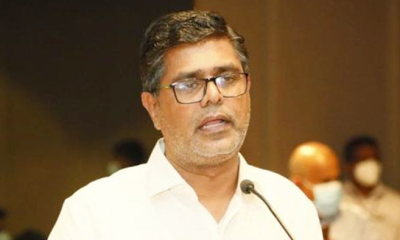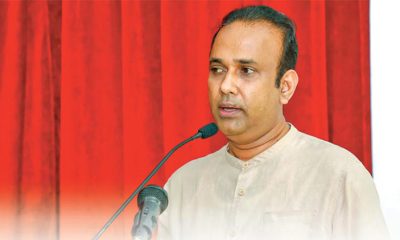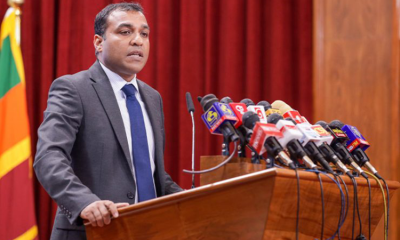Sports
Marvan on spin and way forward for cricket
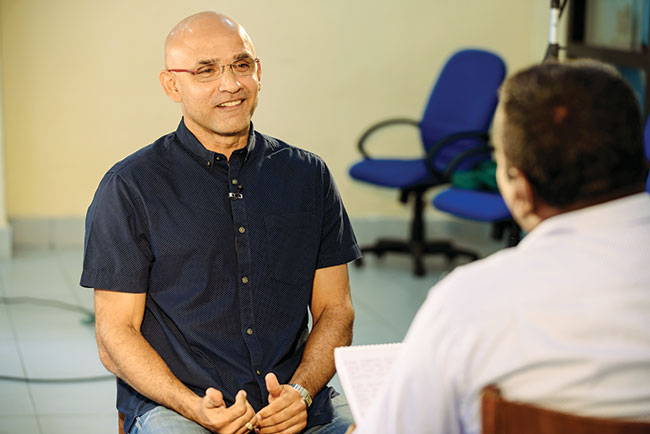
Rex Clementine in Dubai
There’s no better sight in cricket than Marvan Atapattu in full flow. Technically sound, naturally gifted but mindset bit unsettled; five ducks in six innings and all that at the start but he went onto end with more Test runs than his mentor Arjuna Ranatunga. Marvan can be a nervous starter. Wasim Akram sent him down tumbling to the ground with a vicious bouncer at Asgiriya in 2000. Marvan shook off the setback and went onto compile a stunning double hundred against Wasim and Waqar. He also had a successful stint as a coach and was Head Coach when Sri Lanka won their maiden Test series in England in 2014.
Marvan joined a group of journalists here in Dubai virtually from Colombo to discuss on various aspects of the sport and particularly playing spin bowling, Sri Lanka’s Achilees’ heel in recent times.
“I have seen guys like Arjuna and Aravinda murdering Abdul Qadir and Shane Warne. I remember when Warne came over to Sri Lanka for the first time, Arjuna telling the team meeting not to smash 16 runs off him in one over. Instead milk his bowling. That was his plan,” explained Marvan. In other words, don’t smash Warne all over the park as the opposition captain could take him off the bowling. Instead, pick four runs an over, give a false sense of security that the leggie has things under control and end up scoring big runs.
“I can tell a player this is how you play the sweep, where to get your head, where to get your body position, whether you come forward or go on the back foot. It is the players’ skills after sometime that enable him to succeed. The reverse sweep is not in the coaching manual but a stroke that’s quite unique and can produce runs. Warner plays the reverse sweep differently and Maxwell plays it differently. Nobody taught Dilshan to play the scoop. That’s the confidence he had. That’s ‘uncoachable’. But the important things about playing spin is to get your basics right.”
“You either go to the pitch of the ball or you go on the back foot, wait till the ball turns and then play. You can’t play spin half hearted. It’s a matter of time before you are exposed. Aravinda had an interesting theory. Don’t play the same spinner for six balls. If you take Arjuna, when he was struggling to play spin, very smartly he taps the ball to a vacant area and gets the single. Then if Sanath is in the other end, he will smash the next ball for a six to take the pressure off. Now the spinner has forgotten that he is bowling to a different batsman and he will be smashed all over. That is psychology. You have got to be street smart playing spin.”
 Sri Lanka’s options against spin at times have been too risky; sweep. But is it a risk worth taking? “Waruna Waragoda is the best player of spin bowling I have seen. I have tapped into Waruna’s brains on playing spin. I actually asked him to come and help the team on how to play spin when I was coach. But he is a reserved kind of guy and he politely turned it down. He has some amazing tips on playing spin. He had learned the art from Mr. Stanley Jayasinghe. Basically, to play spin, you have to have good feet movement. What most players do right now is to sweep against spin. It’s a high risk shot. You don’t take a risk for one run. That’s what they taught me when I was small. These are basics of the game,” elaborated Marvan.
Sri Lanka’s options against spin at times have been too risky; sweep. But is it a risk worth taking? “Waruna Waragoda is the best player of spin bowling I have seen. I have tapped into Waruna’s brains on playing spin. I actually asked him to come and help the team on how to play spin when I was coach. But he is a reserved kind of guy and he politely turned it down. He has some amazing tips on playing spin. He had learned the art from Mr. Stanley Jayasinghe. Basically, to play spin, you have to have good feet movement. What most players do right now is to sweep against spin. It’s a high risk shot. You don’t take a risk for one run. That’s what they taught me when I was small. These are basics of the game,” elaborated Marvan.
Sri Lanka performed creditably in the ICC T-20 World Cup and Marvan was pleased with the way the young team went about things. “Given the way we played; skill, attitude, passion and moral. I don’t think I have seen that from a Sri Lankan side for a long time. It started happening during the India series at home and then there was more improvement in the South African series that followed. That momentum continued for the World Cup. To be honest, even I was surprised by the way they performed in the World Cup.”
“I am bit old school; if you take Charith Asalanka and Pathum Nissanka they have very good foundation and technique. That’s the most important thing. Apart from that, they have the additional factor on how to improvise and innovate when it comes to T-20 cricket. They are smart lads especially Charith. The decisions he takes, which ball to hit which side to target, that’s pretty clever. Avishka Fernando was an opener and to drag him to number four maybe put some pressure on him. So Pathum came in as an opener instead of Avishka. He was able to find gaps, play the new ball well and he succeeded there but for Avishka it did not work. In a team game that can happen.”
Thanks to the impressive performances of youngsters, Sri Lanka were able to win two games in the second round and came close to beating South Africa and England. “T-20 is the format that gives you most surprises. It’s the format that creates more upsets. In Test cricket, we say that the team that wins most sessions wins the game. It doesn’t work like that way in T-20 cricket. It can go either way. Against South Africa, Lahiru Kumara, the lengths that he bowled weren’t the right lengths. I don’t think he wanted to bowl those lengths. If you ask him, he will say that. Mistakes can happen. More importantly, he will learn from that experience and when he is faced with a crunch situation, he will have better options. On the other hand, the batsman was very lucky. Had he missed or if one had gone high in the air, the tide would have turned in Sri Lanka’s favour. That’s cricket.”
Since the 2015 World Cup, Sri Lanka have been rebuilding and the process has not gone well for them with the country now forced to play qualifiers for ICC events and if they were to have a Champions Trophy, Sri Lanka would miss out as only the top eight teams qualify.
“I learned something from Arjuna and Aravinda. They always said that Sanath and Kalu can get us 90 runs in the first 15 overs, but once we lose wickets, we need to consolidate and need to keep wickets at hand to cash in the last ten overs. That’s the blueprint that we followed except against Pakistan. You can’t do that against Pakistan because you know Wasim and Waqar will bowl the last ten overs. You have to score as many runs as possible in the middle overs and then when it comes to death overs, you have got to play it safe. Against other teams, no matter how much you score earlier on, you have got to consolidate till the 40th over and then you have to break free. Up to the World Cup in 2015, we had some momentum. We tried to maintain the same tempo after the World Cup. We did not believe in building a team and building an innings and stuff like that. Once our seniors were out, we expected too much from our players and we panicked. So, we faced setbacks and we had to take desperate measures and we appointed too many coaches, too many captains and too many managers. We kept doing this and our downfall was steep. We did not look to rebuild on players who had a good base.”
Have we got things right at the moment? “What we saw during the T-20 World Cup, there were lots of positives. We have utility players, solid batsmen, good fielders and bowlers with a bit of mystery aspect. So, we have got most bases covered. But we have to be patient. Simply because we won five games in the World Cup, we are not going to win the next Test series, especially away from home. We need to categorize players. Who is going to play which format and on what conditions. We tend to pick players who do well in T-20 cricket to play Test cricket and vice-versa. It’s not fair on the player too for he will struggle to adjust. There are players who can do that, no doubt about it. But there are also players who need some time to settle in.”
Marvan’s three-year tenure as Sri Lanka captain from 2003 to 2006 was a landmark era. There were good results but more importantly, he had introduced a team culture where players were made to be mindful of the fact that they were ambassadors of their country. For example, in a Test match, all players had to wear their Test cap for the first session of the game like they used to do when they were schoolboys. Every Sri Lankan captain who followed continued the tradition until Dimuth Karunaratne broke it. Under Dimuth, there is a new culture now. Currently, you see a debutant in Praveen Jayawickrama on the field with his shirt not tucked in. These maybe minute things but is that an indication that discipline is eroding? Well, when your three premier players get banned for breaching bio-secure bubble that’s an indication that something is wrong.
“People might say that a cap doesn’t make a difference to your cricket. But these things, small things go a long way. We used to for example start off a game by spending a few quiet moments thinking of our faiths. These are things that I picked up from my former captains and dressing rooms that I was part of. I always believe that you need to know the history of something, whether it’s cricket, religion your grandparents or whatever. If you don’t then you lose your values. Young players should be taught that this is how we gained Test status. When did we win ICC Trophy? This is how much former players earned for a Test match. There’s no future without a past. We have to respect our past.”
“I am told Mahela Jayawardene wants a documentary done on how we started our Test cricket and what’s our past. If you ask the current players, some may not know that Bandula Warnapura was our first Test captain. I still have the HNB cap that was given for our inaugural Test match. I have the stamp that was issued to mark the occasion. My father got it for me and I cherish those things a lot.”
“Grooming a player is not about developing his skill. We should develop his confidence, should develop him socially. We should not only look to develop his batting, bowling and fielding. We should look to develop his social etiquettes, how to handle media, table etiquettes, what to do when they fly overseas. When you teach players those things that gives them lot of confidence. Then only you get a well-roundedplayer. We don’t follow certain protocols. When we are desperate, we look for quick results. We are not methodical. When I was Head Coach, I gave SLC these plans. I took them from England Lions program. But it was not executed. Sad!”
Sports
England face Australia in the battle of champions
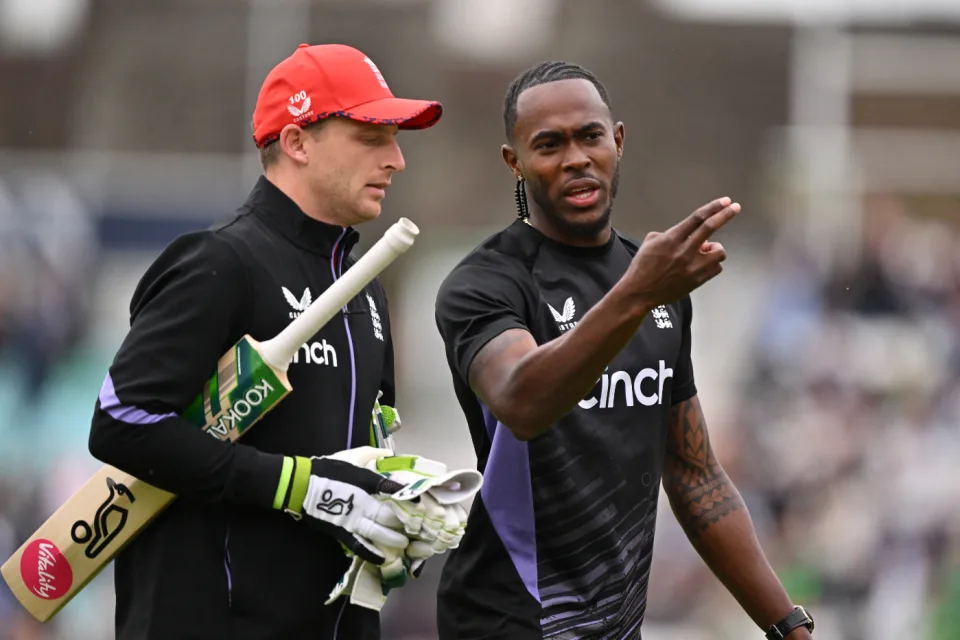
The first truly heavyweight clash of this expanded T20 World Cup format comes freighted with both history and subplots. A rematch of the 2010 World T20 final at Kensington Oval, the match pits Jos Buttler’s defending champions – who are aiming to become the first team to retain the trophy – against the Australian winning machine, victors at the 2021 edition and current world title-holders in Test and ODI cricket. And that’s before you throw in the Ashes for afters.
Already there is added pressure on England, after the rain in Bridgetown led to a share of the points in their opener against Scotland (and that having conceded 90 runs from 10 overs without taking a wicket in a tepid bowling display). Lose to their oldest rivals and it will leave their Super 8 prospects open to being waylaid by the perils of net run-rate calculations, or worse.
The Scotland match was the third abandonment in five suffered by England, after a rain-affected home series against Pakistan, which has clearly hampered their readiness for this campaign after almost six months without playing T20 together. It does not take much for a side to click in this format – and England looked in decent shape when they did get on the field against Pakistan – but Buttler will be anxious for things to go their way on Saturday, if only to avoid further questions referencing the team’s disastrous ODI World Cup defence last year.
Australia, under the laidback leadership of Mitchell Marsh would love nothing more than to add to the English sense of jeopardy – having helped bundle them out of the tournament in India on the way to taking the crown. Their head to head record is less impressive in T20 however, with England having won six of the last seven completed encounters, as well as that 2010 final.
Despite a wobble with the bat, Australia avoided mishap against Oman earlier in the week, the experience of David Warner and Marcus Stoinis shining through in difficult batting conditions. Surfaces in the Caribbean – not to mention those games staged in the USA – have already had teams scratching their heads; rather than the “slug-fest” England had prepared for, following a high-scoring tour of the Caribbean in December, it looks as if boxing smart may be the way to go.
Speaking of Warner, this could be the last time he faces up against England in national colours – and another match-winning contribution would likely reduce the chances of them meeting again in the knockouts. On the other side of the card is Jofra Archer, fresh from an emotional maiden outing at Kensington Oval and ready to take on Australia for the first time in any format since 2020. Can Mark Wood fire up England’s campaign, as he did during last summer’s Ashes? Will Pat Cummins be back to harass the old enemy once again? Seconds out, it’s almost time to rumble.
Cummins is set to return after being rested for the Oman game, which saw Mitchell Starc leave the field with cramp. Starc is understood to be fine and could keep his place – which would likely see Nathan Ellis miss out. Marsh is still not fit to bowl, with Australia likely to continue with the allrounder combination of Stoinis and Maxwell to give them cover.
Australia (probable XI): David Warner, Travis Head, Mitchell Marsh (capt), Glenn Maxwell, Marcus Stoinis, Josh Inglis (wk), Tim David, Pat Cummins, Nathan Ellis/Mitchell Starc, Adam Zampa, Josh Hazlewood
The one change England may consider is Reece Topley coming in for Wood, with the expectation that there will be some rotation among the seamers through the course of the tournament.
England (probable XI): Phil Salt, Jos Buttler (capt & wk), Will Jacks, Jonny Bairstow, Harry Brook, Liam Livingstone, Moeen Ali, Chris Jordan, Jofra Archer, Adil Rashid, Reece Topley/Mark Wood
[Cricinfo]
Sports
South Africa up against their bogey team in batter-unfriendly New York
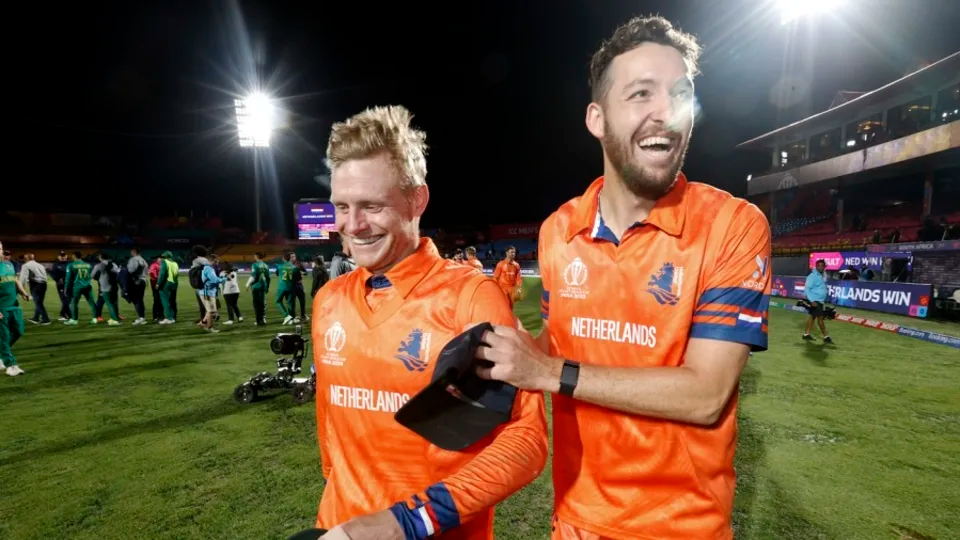
Once is coincidence, twice is a clue, and three times is proof.
To paraphrase Agatha Christie, that is the narrative around South Africa’s meeting with Netherlands at this T20 World Cup.
The Dutch beat South Africa at the 2022 tournament and ended their semi-final hopes in a match where South Africa appeared to be sleep walking, and then beat them again at the 2023 ODI World Cup, where they exposed South Africa’s vulnerability in the chase. If they to do the treble, not only will Netherlands take the lead in Group D, but they will offer conclusive evidence of the threat they pose to Full Members, especially South Africa.
Of course, it will take some doing after South Africa’s opening performance against Sri Lanka, where they reduced their opposition to their lowest T20I total and chased it down in fairly straightforward fashion thanks to the most stable middle-order of their white-ball era. In Aiden Markram, Tristan Stubbs, Heinrich Klaasen and David Miller, South Africa have bankers and big-hitters and, for this match, they also have the advantage of experience. They’ve already played at Eisenhower Park, and have first-hand knowledge that run-scoring doesn’t come easily;Klassen said they are prepared to use their “cricket brains” and play “smarter cricket”.
But the conditions could be good news for Netherlands, who are not naturally a line-up of big hitters and build their innings on a foundation of turning ones into twos. In other words, they tend to take a slightly more conservative approach to batting, which may work well here, but they’ll be wary of the uneven bounce of the surface and will have to come up with plans to counterattack especially against South Africa’s seamers. Their own bowlers were exemplary in Dallas and will look to build on that performance against a line-up that will likely be more proactive than Nepal’s, but who they have managed to keep quiet not once, but twice in the past. Third time’s the charm, they say.
Anrich Nortje’s stunning return to form against Sri Lanka means South Africa may not have to tinker with the bowling combination, and Gerald Coetzee and Tabraiz Shamsi may have to wait their turns to get a game. The batting line-up should be unchanged, with no space for Ryan Rickelton yet.
South Africa: Quinton de Kock (wk), Reeza Hendricks, Aiden Markam, Tristan Stubbs, Heinrich Klaasen (wk), David Miller, Marco Jansen, Keshav Maharaj, Kagiso Rabada, Ottneil Baartman, Anrich Nortje
Conditions in New York may tempt Netherlands to include an extra seamer and they have Kyle Klein in their squad. But it could come at the expense of a shortened batting line-up and they may not want to risk that.
Netherlands: Michael Levitt, Max O’Dowd, Vikramjit Singh, Sybrand Engelbrecht, Scott Edwards (capt, wk), Bas de Leede, Teja Nidamanuru, Logan van Beek, Tim Pringle, Paul van Meekeren, Vivian Kingma
[Cricinfo]
Latest News
Mustafizur, Rishad, Hridoy dazzle in Bangladesh’s tight two-wicket win over Sri Lanka
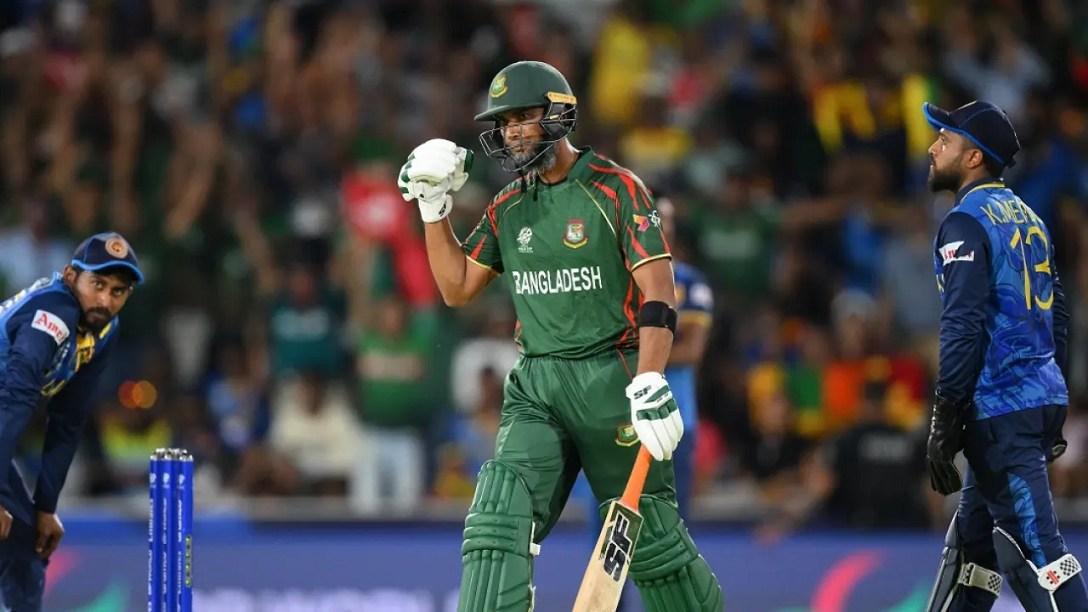
Nuwan Thushara’s last over brought Sri Lanka screaming back into the match,as he first bowled Rishad Hossain, and then nailed Taskin Ahmed in front of the stumps with a pinpoint swinging yorker. This left Bangladesh eight wickets down, with 12 runs still to get.
However, the experienced Mahmudullah was at the crease for Bangladesh, and despite some further nervy moments, pushed Bangladesh across the line off the last ball of the 19th over.
But this was a match chiefly decided by Bangladesh’s own outstanding bowling. Mustafizur Rahman was the best among them, using shorter lengths and his cutters efficiently, to claim figures of 3 for 17. Rishad Hossain’s three-for through the middle overs also kept Sri Lanka quiet.
Mustafizur was instrumental in Sri Lanka’s downward spiral through the middle overs, which culminated in a crash-and-burn end. Ultimately, their inability to find boundaries, or even rotate strike against good Bangladesh bowling resulted in their downfall. A score of 125 for 9 always seemed poor on a decent pitch, even if their bowlers made a match of it in the end.
Brief scores:
Bangladesh 125 for 8 in 19 overs (Towhid Hridoy 40, Litton Das 36; Dhanajaya de Silva 1-11, Nuwan Thushara 4-18, Wanidu Hasaranga 2-32, Matheesha Pathirana 1-27) beat Sri Lanka124 for 9 in 20 overs (Pathum Nissanka 47, Dhananjaya de Silva 21; Tanzim Hasan Sakib 1-24, Taskin Ahmed 2-25, Mustafizur Rahman 3-17, Rishad Hossain 3-22) by two wickets
[Cricinfo]




